利用python實(shí)現(xiàn)平穩(wěn)時間序列的建模方式
一、平穩(wěn)序列建模步驟
假如某個觀察值序列通過序列預(yù)處理可以判定為平穩(wěn)非白噪聲序列,就可以利用ARMA模型對該序列進(jìn)行建模。建模的基本步驟如下:
(1)求出該觀察值序列的樣本自相關(guān)系數(shù)(ACF)和樣本偏自相關(guān)系數(shù)(PACF)的值。
(2)根據(jù)樣本自相關(guān)系數(shù)和偏自相關(guān)系數(shù)的性質(zhì),選擇適當(dāng)?shù)腁RMA(p,q)模型進(jìn)行擬合。
(3)估計模型中位置參數(shù)的值。
(4)檢驗(yàn)?zāi)P偷挠行浴H绻P筒煌ㄟ^檢驗(yàn),轉(zhuǎn)向步驟(2),重新選擇模型再擬合。
(5)模型優(yōu)化。如果擬合模型通過檢驗(yàn),仍然轉(zhuǎn)向不走(2),充分考慮各種情況,建立多個擬合模型,從所有通過檢驗(yàn)的擬合模型中選擇最優(yōu)模型。
(6)利用擬合模型,預(yù)測序列的將來走勢。
二、代碼實(shí)現(xiàn)
1、繪制時序圖,查看數(shù)據(jù)的大概分布
trainSeting.head()Out[36]: date2017-10-01 126.42017-10-02 82.42017-10-03 78.12017-10-04 51.12017-10-05 90.9Name: sales, dtype: float64plt.plot(trainSeting)
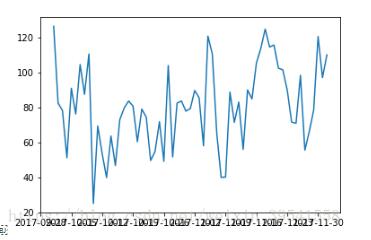
2、平穩(wěn)性檢驗(yàn)
’’’進(jìn)行ADF檢驗(yàn)adf_test的返回值Test statistic:代表檢驗(yàn)統(tǒng)計量p-value:代表p值檢驗(yàn)的概率Lags used:使用的滯后k,autolag=AIC時會自動選擇滯后Number of Observations Used:樣本數(shù)量Critical Value(5%) : 顯著性水平為5%的臨界值。(1)假設(shè)是存在單位根,即不平穩(wěn);(2)顯著性水平,1%:嚴(yán)格拒絕原假設(shè);5%:拒絕原假設(shè),10%類推。(3)看P值和顯著性水平a的大小,p值越小,小于顯著性水平的話,就拒絕原假設(shè),認(rèn)為序列是平穩(wěn)的;大于的話,不能拒絕,認(rèn)為是不平穩(wěn)的(4)看檢驗(yàn)統(tǒng)計量和臨界值,檢驗(yàn)統(tǒng)計量小于臨界值的話,就拒絕原假設(shè),認(rèn)為序列是平穩(wěn)的;大于的話,不能拒絕,認(rèn)為是不平穩(wěn)的’’’#滾動統(tǒng)計def rolling_statistics(timeseries): #Determing rolling statistics rolmean = pd.rolling_mean(timeseries, window=12) rolstd = pd.rolling_std(timeseries, window=12) #Plot rolling statistics: orig = plt.plot(timeseries, color=’blue’,label=’Original’) mean = plt.plot(rolmean, color=’red’, label=’Rolling Mean’) std = plt.plot(rolstd, color=’black’, label = ’Rolling Std’) plt.legend(loc=’best’) plt.title(’Rolling Mean & Standard Deviation’) plt.show(block=False) ##ADF檢驗(yàn)from statsmodels.tsa.stattools import adfullerdef adf_test(timeseries): rolling_statistics(timeseries)#繪圖 print (’Results of Augment Dickey-Fuller Test:’) dftest = adfuller(timeseries, autolag=’AIC’) dfoutput = pd.Series(dftest[0:4], index=[’Test Statistic’,’p-value’,’#Lags Used’,’Number of Observations Used’]) for key,value in dftest[4].items(): dfoutput[’Critical Value (%s)’%key] = value #增加后面的顯著性水平的臨界值 print (dfoutput) adf_test(trainSeting) #從結(jié)果中可以看到p值為0.1097>0.1,不能拒絕H0,認(rèn)為該序列不是平穩(wěn)序列
返回結(jié)果如下
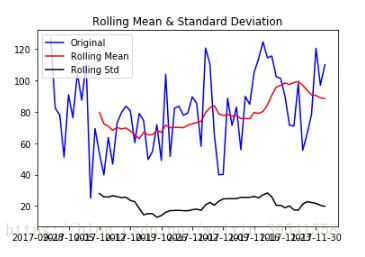
Results of Augment Dickey-Fuller Test:Test Statistic -5.718539e+00p-value 7.028398e-07#Lags Used 0.000000e+00Number of Observations Used 6.200000e+01Critical Value (1%) -3.540523e+00Critical Value (5%) -2.909427e+00Critical Value (10%) -2.592314e+00dtype: float64
通過上面可以看到,p值小于0.05,可以認(rèn)為該序列為平穩(wěn)時間序列。
3、白噪聲檢驗(yàn)
’’’acorr_ljungbox(x, lags=None, boxpierce=False)函數(shù)檢驗(yàn)無自相關(guān)lags為延遲期數(shù),如果為整數(shù),則是包含在內(nèi)的延遲期數(shù),如果是一個列表或數(shù)組,那么所有時滯都包含在列表中最大的時滯中boxpierce為True時表示除開返回LB統(tǒng)計量還會返回Box和Pierce的Q統(tǒng)計量返回值:lbvalue:測試的統(tǒng)計量pvalue:基于卡方分布的p統(tǒng)計量bpvalue:((optionsal), float or array) ? test statistic for Box-Pierce testbppvalue:((optional), float or array) ? p-value based for Box-Pierce test on chi-square distribution’’’from statsmodels.stats.diagnostic import acorr_ljungboxdef test_stochastic(ts,lag): p_value = acorr_ljungbox(ts, lags=lag) #lags可自定義 return p_value
test_stochastic(trainSeting,[6,12])Out[62]: (array([13.28395274, 14.89281684]), array([0.03874194, 0.24735042]))
從上面的分析結(jié)果中可以看到,延遲6階的p值為0.03<0.05,因此可以拒絕原假設(shè),認(rèn)為該序列不是白噪聲序列。
4、確定ARMA的階數(shù)
(1)利用自相關(guān)圖和偏自相關(guān)圖
####自相關(guān)圖ACF和偏相關(guān)圖PACFimport statsmodels.api as smdef acf_pacf_plot(ts_log_diff): sm.graphics.tsa.plot_acf(ts_log_diff,lags=40) #ARIMA,q sm.graphics.tsa.plot_pacf(ts_log_diff,lags=40) #ARIMA,p acf_pacf_plot(trainSeting) #查看數(shù)據(jù)的自相關(guān)圖和偏自相關(guān)圖
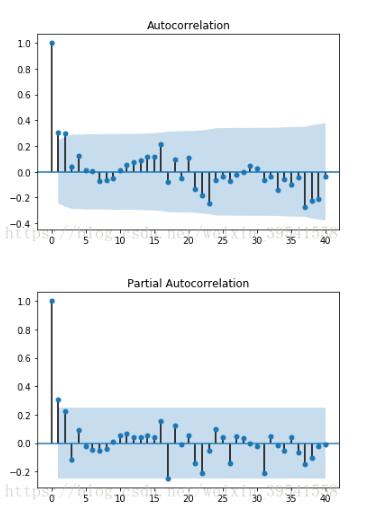
(2)借助AIC、BIC統(tǒng)計量自動確定
##借助AIC、BIC統(tǒng)計量自動確定from statsmodels.tsa.arima_model import ARMAdef proper_model(data_ts, maxLag): init_bic = float('inf') init_p = 0 init_q = 0 init_properModel = None for p in np.arange(maxLag): for q in np.arange(maxLag): model = ARMA(data_ts, order=(p, q)) try: results_ARMA = model.fit(disp=-1, method=’css’) except: continue bic = results_ARMA.bic if bic < init_bic: init_p = p init_q = q init_properModel = results_ARMA init_bic = bic return init_bic, init_p, init_q, init_properModel proper_model(trainSeting,40)
#在statsmodels包里還有更直接的函數(shù):import statsmodels.tsa.stattools as storder = st.arma_order_select_ic(ts_log_diff2,max_ar=5,max_ma=5,ic=[’aic’, ’bic’, ’hqic’])order.bic_min_order’’’我們常用的是AIC準(zhǔn)則,AIC鼓勵數(shù)據(jù)擬合的優(yōu)良性但是盡量避免出現(xiàn)過度擬合(Overfitting)的情況。所以優(yōu)先考慮的模型應(yīng)是AIC值最小的那一個模型。為了控制計算量,我們限制AR最大階不超過5,MA最大階不超過5。 但是這樣帶來的壞處是可能為局部最優(yōu)。timeseries是待輸入的時間序列,是pandas.Series類型,max_ar、max_ma是p、q值的最大備選值。order.bic_min_order返回以BIC準(zhǔn)則確定的階數(shù),是一個tuple類型
返回值如下:
order.bic_min_orderOut[13]: (1, 0)
5、建模
從上述結(jié)果中可以看到,可以選擇AR(1)模型
################################模型####################################### AR模型,q=0#RSS是殘差平方和# disp為-1代表不輸出收斂過程的信息,True代表輸出from statsmodels.tsa.arima_model import ARIMAmodel = ARIMA(trainSeting,order=(1,0,0)) #第二個參數(shù)代表使用了二階差分results_AR = model.fit(disp=-1)plt.plot(trainSeting)plt.plot(results_AR.fittedvalues, color=’red’) #紅色線代表預(yù)測值plt.title(’RSS:%.4f’ % sum((results_AR.fittedvalues-trainSeting)**2))#殘差平方和
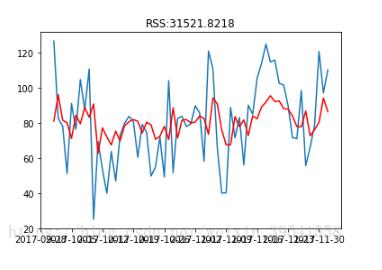
6、預(yù)測未來走勢
############################預(yù)測未來走勢########################################### forecast方法會自動進(jìn)行差分還原,當(dāng)然僅限于支持的1階和2階差分forecast_n = 12 #預(yù)測未來12個天走勢forecast_AR = results_AR.forecast(forecast_n)forecast_AR = forecast_AR[0]print (forecast_AR)
print (forecast_ARIMA_log)[90.49452199 84.05407353 81.92752342 81.22536496 80.99352161 80.91697003
80.89169372 80.88334782 80.88059211 80.87968222 80.87938178 80.87928258]
##將預(yù)測的數(shù)據(jù)和原來的數(shù)據(jù)繪制在一起,為了實(shí)現(xiàn)這一目的,我們需要增加數(shù)據(jù)索引,使用開源庫arrow:import arrowdef get_date_range(start, limit, level=’day’,format=’YYYY-MM-DD’): start = arrow.get(start, format) result=(list(map(lambda dt: dt.format(format) , arrow.Arrow.range(level, start,limit=limit)))) dateparse2 = lambda dates:pd.datetime.strptime(dates,’%Y-%m-%d’) return map(dateparse2, result) # 預(yù)測從2017-12-03開始,也就是我們訓(xùn)練數(shù)據(jù)最后一個數(shù)據(jù)的后一個日期new_index = get_date_range(’2017-12-03’, forecast_n)forecast_ARIMA_log = pd.Series(forecast_AR, copy=True, index=new_index)print (forecast_ARIMA_log.head())##繪圖如下plt.plot(trainSeting,label=’Original’,color=’blue’)plt.plot(forecast_ARIMA_log, label=’Forcast’,color=’red’)plt.legend(loc=’best’)plt.title(’forecast’)
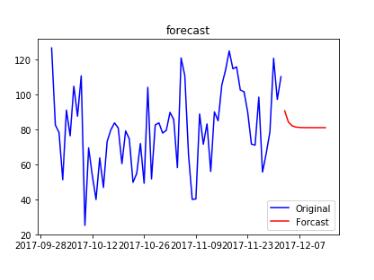
以上這篇利用python實(shí)現(xiàn)平穩(wěn)時間序列的建模方式就是小編分享給大家的全部內(nèi)容了,希望能給大家一個參考,也希望大家多多支持好吧啦網(wǎng)。
相關(guān)文章:
1. ASP基礎(chǔ)知識VBScript基本元素講解2. Python requests庫參數(shù)提交的注意事項(xiàng)總結(jié)3. IntelliJ IDEA導(dǎo)入jar包的方法4. ajax請求添加自定義header參數(shù)代碼5. 使用Python和百度語音識別生成視頻字幕的實(shí)現(xiàn)6. 詳談ajax返回數(shù)據(jù)成功 卻進(jìn)入error的方法7. Kotlin + Flow 實(shí)現(xiàn)Android 應(yīng)用初始化任務(wù)啟動庫8. 使用python 計算百分位數(shù)實(shí)現(xiàn)數(shù)據(jù)分箱代碼9. vue-electron中修改表格內(nèi)容并修改樣式10. python操作mysql、excel、pdf的示例
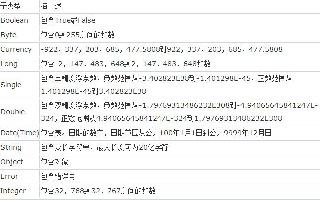
 網(wǎng)公網(wǎng)安備
網(wǎng)公網(wǎng)安備